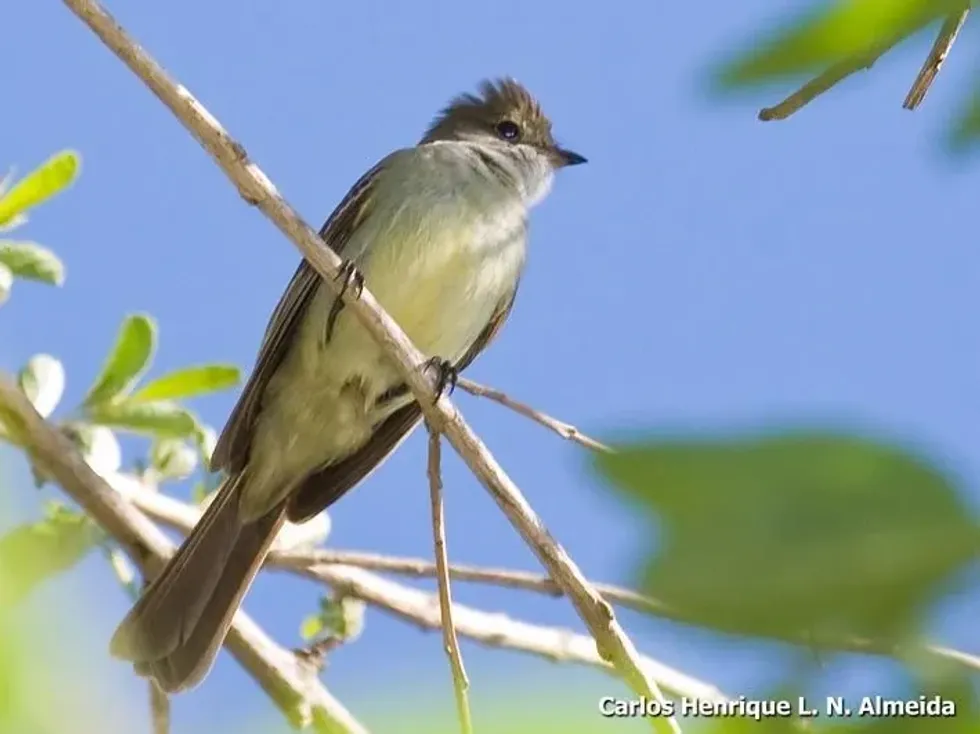Elaenia is a genus of new world passerines that consists of 22 different species of birds. They are found throughout South America and extend up to Mexico.
Some common Elaenia birds are Mountain Elaenia, Chilean Elaenia, small-bellied Elaenia, and yellow-bellied Elaenia. Among all the species of Elaenia, the yellow-bellied Elaenia is considered to be the representative species of the genus. These birds belong to the family of tyrant flycatchers and occur throughout the entire range of Elaenia.
Some birds have a stable population trend while some species are increasing in numbers. There are also several flycatcher species whose population is decreasing.
The yellow-bellied Elaenia is divided into four subspecies based on the differences in their areas of occurrence. Elaenia flavogaster subpagana occurs in the southeastern parts of Mexico, south Costa Rica, southwest Panama and south Veracruz.
Elaenia flavogaster flavogaster is the most widespread yellow-bellied Elaenia distributed throughout Colombia, Venezuela, Brazil, Bolivia, northeast and northwest Argentina, and Peru. The subspecies Elaenia flavogaster semipagana and Elaenia flavogaster pallididorsalis inhabit southwest Colombia and Panama islands, respectively. To know more about the bird species, keep on reading.
For similar content, check out southwestern willow flycatcher and brown-crested flycatcher too.
Elaenia Interesting Facts
What type of animal is Elaenia?
Elaenia is a group of songbirds belonging to the family of new world tyrant flycatcher.
What class of animal does Elaenia belong to?
The Elaenia flycatcher of the Passeriformes order and Tyrannidae family belong to the class Aves, the common class for all birds.
How many Elaenias are there in the world?
The Elaenia flycatcher genus consists of several species, and as a result, the population status of all species does not match. The type species of Elaenia, yellow-bellied Elaenia, are currently stable in their natural habitats.
Their population has not been quantified accurately. It is assumed that around 5,000,000-50,000,000 individuals are present throughout their entire range. Their population does not face any major threat as of yet; therefore, the yellow-bellied Elaenia population is believed to be stable throughout their range.
Where do Elaenias live?
The species of Elaenia are distributed over a large range covering Central and South America. Few Elaenia bird species are also found in Mexico and the Caribbean islands.
What is Elaenia's habitat?
Elaenias are found along the humid tropical forest of Mexico up to South America. They are commonly found in lightly wooded habitats, including semi-open scrubland, savanna, gardens, and river banks.
They occur along the external forest edges and secondary growth with scattered trees and weed clearings and are generally absent from the interiors of dense forests. These extremely adaptive birds can also co-exist in towns and gardens along with human beings.
Who do Elaenias live with?
The Elaenia flycatcher species generally lives in solitude. They form pairs prior to the breeding season and live with their partner until the chicks fledge. Sometimes the flycatcher species are observed to forage in large gatherings, flocking together at fruiting trees.
How long do Elaenias live?
The lifespan of the Elaenia flycatcher varies depending on the species. The Caribbean Elaenia has a lifespan of 14 years, while the oldest white-crested Elaenia ever recorded was around eight years old. The lifespan of yellow-bellied Elaenia is unknown. Therefore the average lifespan of all Elaenia flycatchers has not been successfully determined.
How do they reproduce?
The breeding season of the Elaenia flycatcher lasts from February to September, but sometimes breeding is also recorded as late as November and December. The yellow-bellied Elaenia is observed to build their nest during March. The bird builds a neat cup-shaped nest with moss and grass.
The nests are lined with feathers, barks, and lichens. The female bird generally lays two eggs in a single clutch. However, the clutch size is observed to range between one to three eggs. They can produce up to two broods in a single season.
The eggs are incubated by the females for 16 days. Both parents provide parental care to the chicks. Fledging occurs after 15-17 days after the eggs hatch.
What is their conservation status?
All the 21 species of Elaenia flycatcher, except Noronha Elaenia, are classified as Least Concern species in the IUCN Red List. The main reason for considering the flycatcher family as the least concerned species is their large range.
For example, the yellow-bellied Elaenia is widespread throughout an extremely large range in Mexico and South America with a fairly large population.
Therefore they do not approach the threshold of endangered species either in the range criteria or in population criteria. Apart from that, their occurrence in various national parks and protected areas suggests that this species is reasonably secure in its native range.
Elaenia Fun Facts
What do Elaenias look like?
Elaenias are mid-sized pale-looking birds, unlike the vermillion flycatchers. Yellow-bellied Elaenias have an olive-brown plumage.
They have a small head with a bushy crest on top, like the great crested flycatcher. The white coronal patch on the tor of the head is visible through the crest. The wings and the tails have a more defined brown plumage than the back, with two white bars on the wings.
The breast feathers range from pale grey to olive-grey, and the belly looks pale yellowish in color. The male and the female yellow-bellied Elaenias have similar plumage.
How cute are they?
Elaenias with small heads and pudgy structures look quite cute in the wild.
How do they communicate?
Elaenias are songbirds that communicate mainly by vocalizations. The yellow-bellied bird produces a rough 'breer-breer' call.
How big is an Elaenia?
The length of a yellow-bellied Elaenia ranges between 6.2-6.6 in (16-17 cm). They are larger in size than the least flycatchers.
How fast can an Elaenia fly?
Elaenias are fast-flying birds. Unfortunately, their flying speed has not been determined yet.
How much does an Elaenia weigh?
The weight of a yellow-bellied Elaenia ranges between 0.7-1 oz (21-29 g).
What are the male and female names of the species?
A male Elaenia is referred to as a cock, while a female is known as a hen.
What would you call a baby Elaenia?
A baby Elaenia is called a chick.
What do they eat?
Elaenias, like yellow-bellied Elaenias, are omnivorous birds. The bird feeds on fruits and berries and consumes insects as well.
Are they dangerous?
No, they are not dangerous.
Would they make a good pet?
No, they do not make good pets.
Did you know...
Elaenias were discovered in 1836 by the Swedish zoologist Carl Jakob Sundevall.
What is special about Elaenias?
Elaenias are a type of songbird that belongs to the family of tyrant flycatchers. The species of Elaenia cant be separated from each other easily since they appear similar. Each species have different kinds of songs which plays a major role in their identification.
Are they endemic?
Elaenias are songbirds that are endemic to South and Central America. The representative bird species, yellow-bellied Elaenias, are native to southern Mexico as well as parts of Central and South America.
Here at Kidadl, we have carefully created lots of interesting family-friendly animal facts for everyone to discover! For more relatable content, check out these sea eagle facts and gray flycatcher facts for kids.
You can even occupy yourself at home by coloring in one of our free printable bird coloring pages.
Main image by Carlos Henrique Luz Nunes de Almeida and second image by Henrique Moutinho.









